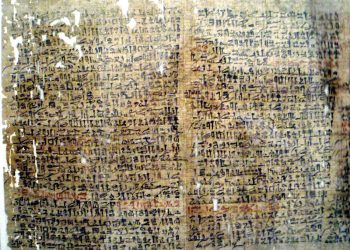Did the Ancient Egyptians Unlock the Secrets of a Star 92 Light-Years Away Over 3,000 Years Ago?
The ancient Egyptians left behind incredible monuments and a vast trove of knowledge. But what if they also unlocked the secrets of the stars? According to recent research, these ancient astronomers may have discovered a variable star located 92 light-years away—without the aid of telescopes—some 3,200 years ago.
How did they manage this feat? And what does this discovery tell us about their understanding of the universe?
Algol: A Celestial Puzzle for the Ages
Researchers from the University of Helsinki believe that a centuries-old Egyptian papyrus contains the earliest recorded observations of the variable star Algol, part of a three-star system that lies 92 light-years from Earth. This ancient text, known as the Cairo Calendar, is much more than a simple list of festivals and events—it may hold a deeper understanding of celestial mechanics hidden in plain sight.
For modern scientists, Algol is a well-known star system where the brightness changes as its stars eclipse one another. What’s astonishing is that the Egyptians seem to have documented this star’s fluctuating brightness long before such knowledge was common. But why would a star, invisible to the naked eye for most of its cycle, be so important to them?
Star-Gazing or Divine Communication?
It turns out, Algol wasn’t just a cosmic curiosity—it may have been central to Egyptian mythology and kingship. According to the new research, the Egyptians likely associated Algol with the god Horus, the falcon-headed deity representing royalty and the sky. Could the Egyptians have interpreted Algol’s varying brightness as a divine signal from their gods?
Their astronomy and mythology were deeply intertwined. The actions of Horus, described in mythological texts, align closely with Algol’s eclipsing cycle, suggesting that the Egyptians didn’t merely observe the stars; they believed the stars were living participants in their spiritual world.
A Calendar Written in the Stars
The Cairo Calendar is more than just a relic—it’s an intricate system marking favorable and unfavorable days based on the movements of celestial bodies, including Algol and the Moon. Researchers have discovered that periods of positive days in the calendar align with the brightest phases of Algol’s cycle and the full moon.
But why did these ancient astronomers track these celestial events so closely? The calendar served both spiritual and practical purposes, guiding rituals, agricultural planning, and royal ceremonies. This makes the discovery of Algol’s importance all the more fascinating. It suggests that the Egyptians may have believed their gods were guiding their actions through the movements of the stars.
What We Still Don’t Know
Despite their remarkable achievements, many questions remain. Could the Egyptians have known about other distant stars that we haven’t yet uncovered? How did they develop such precise astronomical observations without modern tools?
As we continue to analyze ancient texts like the Cairo Calendar, the answers may lie in the knowledge that’s been hidden for thousands of years, waiting to be rediscovered.











